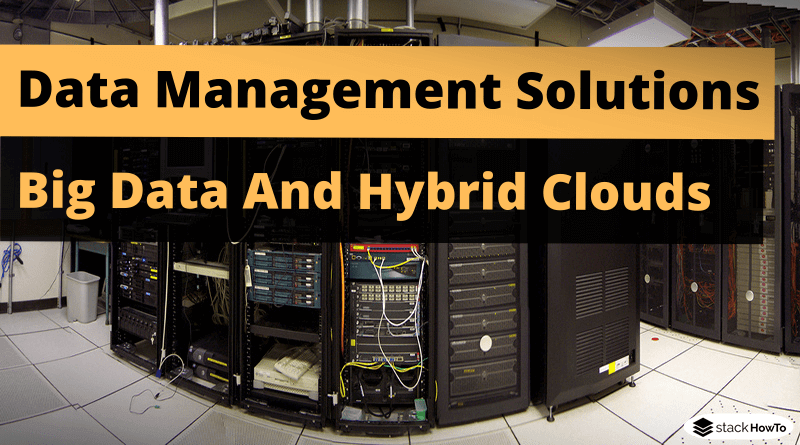Data Management Solutions: Big Data And Hybrid Clouds
The management of Big Data is now part of everyday business for almost every company. But it is not always clear, which approaches and solutions are suitable for actually getting the best out of Big Data for your own goals. The IT infrastructure is the foundation for data management for most decision-makers. But this is also changing at a rapid pace – and thus offers new approaches to solutions.
Hybrid Data Management – where to start?

“Digitization” is often used as a buzzword to refer to necessary innovation processes and almost unlimited potential. However, the actual depth of the associated changes and further developments can usually only be measured when it comes to application and implementation in a specific case.
Because digitization does not just mean that ever larger, ever more detailed volumes of data are available, but with the growth of big data, the solutions change at the same time in order to collect, process, and analyze them efficiently. Being up-to-date when it comes to technology is therefore one of the basic requirements for in-house data management to become a real competitive advantage.
Investments in technology and IT infrastructure are therefore to a certain extent mandatory: data centers, connected devices, and their hardware, as well as the software used, should be adapted to the respective application areas and processes as best as possible. The key questions are how to achieve what is the fastest and (most cost) efficient.
This already reveals the complexity of the digital transformation, as the IT infrastructure is already a multi-layered structure in which both fundamental and detailed questions must be clarified. What, for example, must the software be able to do – e.g. Extract information from unstructured formats, visualize data (in real-time and/or 3D) – and what different requirement profiles and capacities in terms of timing or number of cores do the processors used for such tasks have to offer?
Can a company build the required infrastructure independently or is there a lack of resources? After all, it’s not just about the technology alone, but also about its support, control, and further development. This not only requires the appropriate know-how, but also the necessary time and personnel to keep the technical foundation up to date.
Cloud computing as an alternative

Especially for small and even medium-sized companies, the associated effort may be too high. Cloud computing, therefore, offers a leaner “solution” for the desired IT infrastructure and data management. This gives companies the opportunity to outsource many basic resources: hardware and software can be used via the cloud, a dedicated data center, or their own software development are largely eliminated – just like many costs.
They are created elsewhere, because such an infrastructure, which has hardly anything to do with the usual company networks, cannot be implemented without rethinking and transformation processes. This is true as cloud technologies, like any other digital technology, change quickly.
Public or private cloud?
The requirements for the cloud change just as quickly. In its public version, this is initially sufficient to make use of the desired computing services from the external provider – who makes hardware and software available. The weak point is the permanent Internet connection that is absolutely necessary for this.
Not so much because of the stability and speed it takes to manage and process large amounts of data. The problem is that the permanent connection provides a point of attack to gain unauthorized access to critical data and applications. For reasons of data protection law, the public cloud is therefore not suitable for all data and processes.
That is why such critical applications are often moved to a private cloud. Unlike the public cloud, it can be hosted via the company’s own data center. The applications and data are only accessible to the employees, access via the Internet is excluded – simple authorization mechanisms for the users, often in connection with firewalls, secure the internal cloud. In this way, companies guarantee the security that a public cloud lacks due to its structure.
At the same time, the company has full control over the private cloud and can, for example, adapt the computing power to the individual needs of the users and services without having to compromise on data security.
Advantages and disadvantages of public and private clouds
How exactly the infrastructure is designed for the respective cloud solutions is basically at the discretion of the companies that want to use them. These different approaches in turn bring their own difficulties. This starts with the question of how a company wants to deal with the software for its work processes.
With cloud computing, the solution is to avoid physically store the software on a company’s own server; instead, it is provided in the SaaS model (Software as a Service). The advantage for the company: As a user of such a service, he does not have to worry about maintenance or the operation of the necessary hardware and software – that remains the responsibility of the provider. However, the use of SaaS does not work without its disadvantage: outsourcing contracts are common, primarily to clarify aspects of data protection law. These contracts relate either to the use itself or the duration of use.
Unlike, on-premise infrastructures which follow a different model. The data and applications are also mostly obtained from third parties – i.e. from experts who adapt the software to the specific requirements of the company according to the company’s wishes – but this data is stored on the licensee’s computers.
Compared to a pure cloud solution, the hardware requirements have to be created, and there are significantly higher costs to transfer the tailor-made software to the internal systems. A later update is also more difficult.
For this purpose, it is possible for the management of big data to relieve the company’s own networks by allowing the On-Premise applications to run exactly where the collected data requires. In this context, the explanations on hybrid data management offered by IBM speak of the “attraction” of large amounts of data.
In principle, this can also be achieved with cloud computing, but the cost factor is also relevant here: while the financial cost for uploading and storing data in the cloud is comparatively cheap, for example, it is often different when retrieving it. In addition, the more complex the processing of the data, the greater the effort – and the greater the costs.
More flexibility through hybrid clouds
Big data can therefore only be managed with a high degree of flexibility. Therefore, hybrid clouds try to combine the advantages of private clouds, public clouds, and on-premise into a more efficient whole. This applies both to the data processing itself and to the resulting costs. The potential of cloud computing can be used in areas of application in which, for example, on-prem solutions would be too costly due to ongoing software updates.
Critical and non-critical applications and data can also be related more easily without having to take unnecessary risks in terms of security and data protection: A sensitive database can be created and managed within the private cloud, while the connected web applications can be created using the public cloud.
However, a significantly higher effort is required for such a design to function smoothly. The IT infrastructure becomes more complex through the use of both cloud models, which increases the management effort. In addition, there is an ongoing analysis of all processes in order to work as efficiently as possible and as safely as possible. Because there is a risk of transferring data to the wrong cloud.
The possibility of being able to achieve a clear separation of data storage (on internal databases of the private cloud) and data analysis (with the applications of the public cloud) thanks to the hybrid solution, considers this effort especially with regard to the intensive data management in the big data area back on. Large amounts of data can only be used meaningfully with lean and flexible models.
Of course, hybrid clouds are not the end of development. In the area of production, among other things, multi-clouds are increasingly being used, with which application areas can be divided up even better. At the same time, this means a further relief of the network, since the data analysis can be carried out precisely at the desired points.





